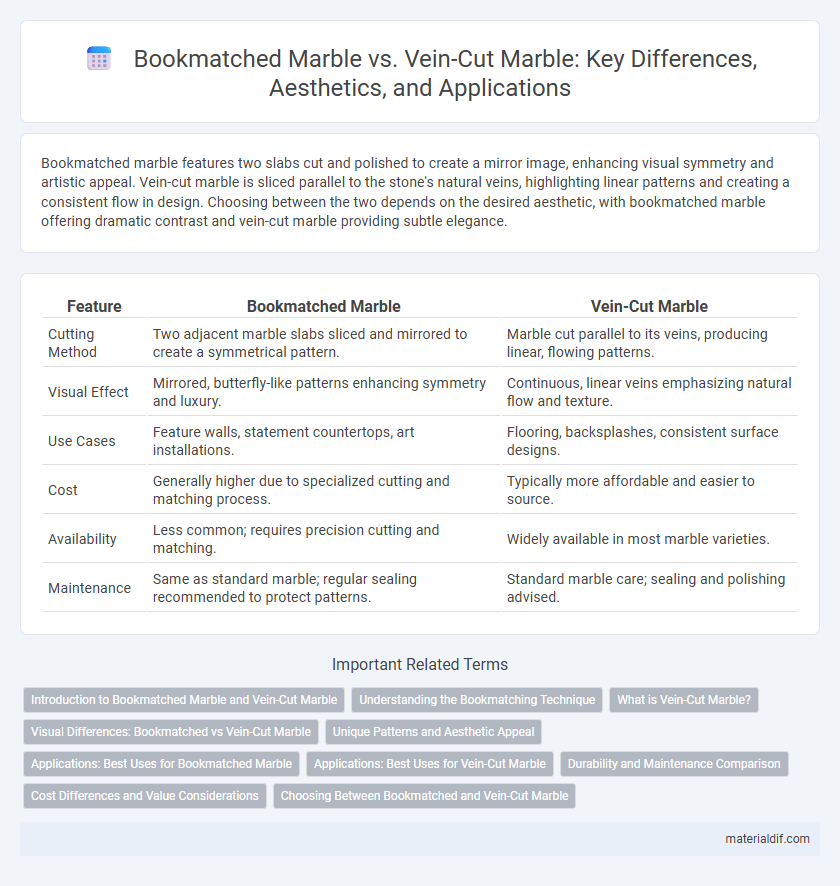Bookmatched marble features two slabs cut and polished to create a mirror image, enhancing visual symmetry and artistic appeal. Vein-cut marble is sliced parallel to the stone's natural veins, highlighting linear patterns and creating a consistent flow in design. Choosing between the two depends on the desired aesthetic, with bookmatched marble offering dramatic contrast and vein-cut marble providing subtle elegance.
Table of Comparison
| Feature | Bookmatched Marble | Vein-Cut Marble |
|---|---|---|
| Cutting Method | Two adjacent marble slabs sliced and mirrored to create a symmetrical pattern. | Marble cut parallel to its veins, producing linear, flowing patterns. |
| Visual Effect | Mirrored, butterfly-like patterns enhancing symmetry and luxury. | Continuous, linear veins emphasizing natural flow and texture. |
| Use Cases | Feature walls, statement countertops, art installations. | Flooring, backsplashes, consistent surface designs. |
| Cost | Generally higher due to specialized cutting and matching process. | Typically more affordable and easier to source. |
| Availability | Less common; requires precision cutting and matching. | Widely available in most marble varieties. |
| Maintenance | Same as standard marble; regular sealing recommended to protect patterns. | Standard marble care; sealing and polishing advised. |
Introduction to Bookmatched Marble and Vein-Cut Marble
Bookmatched marble features pairs of marble slabs cut from the same block and polished to mirror each other, creating symmetrical patterns that enhance the visual appeal in interior design. Vein-cut marble is sliced perpendicular to the natural veins in the stone, showcasing linear, consistent striations ideal for sleek and modern aesthetics. Both techniques highlight the unique characteristics of marble, with bookmatching emphasizing symmetry and vein-cutting emphasizing linear texture.
Understanding the Bookmatching Technique
Bookmatched marble is created by slicing a single marble block into slabs and opening them like the pages of a book, resulting in mirrored, symmetrical patterns ideal for striking visual effects. In contrast, vein-cut marble is cut parallel to the stone's natural veins, emphasizing linear patterns and consistency. Understanding the bookmatching technique highlights how artisans enhance the aesthetic appeal of marble surfaces, making it a preferred choice for feature walls and luxury interiors.
What is Vein-Cut Marble?
Vein-cut marble is created by slicing the stone parallel to its natural veins, revealing linear patterns that emphasize the marble's striations and texture. This cutting technique highlights the stone's grain and produces a more elongated, flowing appearance compared to other cuts. Vein-cut marble is often chosen for its dramatic and consistent veining, making it ideal for striking countertops, feature walls, and flooring.
Visual Differences: Bookmatched vs Vein-Cut Marble
Bookmatched marble showcases two adjacent slabs mirrored to create a symmetrical pattern resembling an open book, emphasizing dramatic, flowing veining that forms a striking centerpiece. Vein-cut marble is sliced parallel to the vein direction, producing linear, consistent patterns that highlight elongated striations and subtle tonal variations. These contrasting visual effects influence design choices, with bookmatched offering bold symmetry and vein-cut providing understated elegance.
Unique Patterns and Aesthetic Appeal
Bookmatched marble showcases a symmetrical, mirrored pattern created by slicing a single slab into two and opening them like a book, resulting in visually striking and unique designs ideal for feature walls and luxury interiors. Vein-cut marble, on the other hand, is cut perpendicular to the veining, highlighting linear, flowing patterns that enhance spaces with elegance and continuity. Both methods emphasize the natural beauty of marble, but bookmatched slabs offer a more dramatic and artistic aesthetic compared to the subtle, classic appeal of vein-cut marble.
Applications: Best Uses for Bookmatched Marble
Bookmatched marble is ideal for high-impact visual applications such as feature walls, fireplace surrounds, and luxury countertops where the symmetrical patterns create a dramatic focal point. Its mirrored veining enhances large surfaces like reception desks and statement flooring, making spaces appear more cohesive and artistic. This type of marble is preferred in upscale interior design projects seeking elegance and refined craftsmanship.
Applications: Best Uses for Vein-Cut Marble
Vein-cut marble, characterized by its linear and symmetrical patterns, is ideal for applications requiring a sleek and continuous design flow, such as wall cladding, flooring, and large countertops. Its consistent veins enhance the visual elongation of spaces, making it perfect for long corridors, expansive foyers, and feature walls. This marble type's structural integrity suits commercial settings, luxury bathrooms, and modern kitchens where uniformity and elegance are essential.
Durability and Maintenance Comparison
Bookmatched marble features symmetrical patterns created by slicing a block and opening it like a book, enhancing visual appeal but not impacting durability, which depends primarily on the marble's mineral composition and finish. Vein-cut marble, cut parallel to the stone's veins, often exhibits linear patterns and generally shares similar hardness and resistance to scratches and stains as bookmatched marble. Maintenance for both involves regular sealing and gentle cleaning to prevent etching and staining, with no significant differences in upkeep requirements.
Cost Differences and Value Considerations
Bookmatched marble involves pairing two slabs with mirrored veins, creating a symmetrical and visually striking effect often preferred in luxury applications. Vein-cut marble, cut parallel to the veining, tends to be more affordable due to simpler processing and less waste during fabrication. The higher cost of bookmatched marble reflects its rarity and aesthetic value, making it a worthwhile investment for high-end projects seeking unique elegance.
Choosing Between Bookmatched and Vein-Cut Marble
Choosing between bookmatched and vein-cut marble depends on the desired visual impact and design style. Bookmatched marble offers a mirrored, symmetrical pattern that enhances elegance and sophistication, making it ideal for feature walls or statement installations. Vein-cut marble showcases linear veining with a subtle flow, providing a more traditional and consistent appearance suitable for flooring and large surface areas.
Bookmatched Marble vs Vein-Cut Marble Infographic

 materialdif.com
materialdif.com